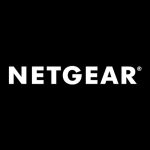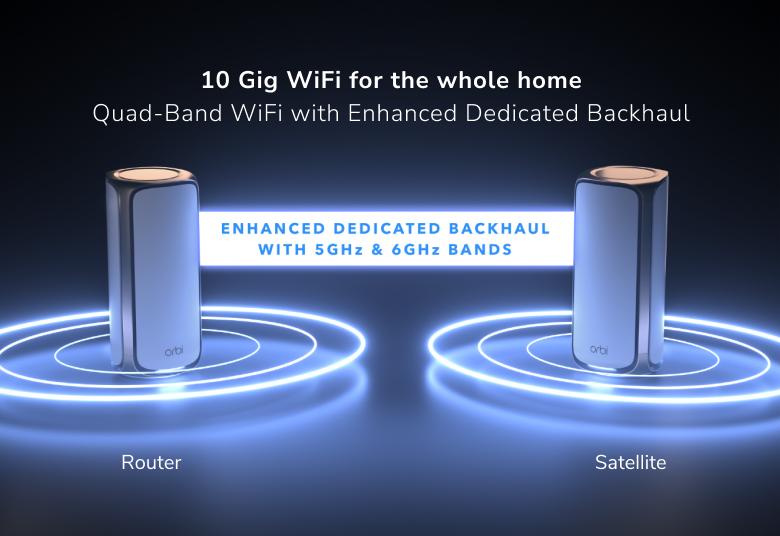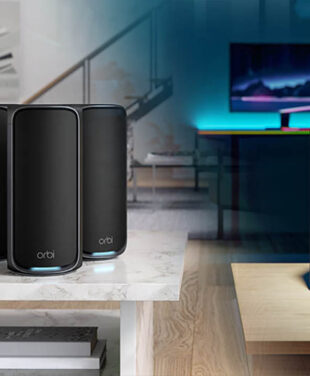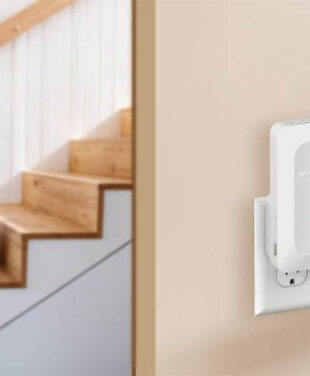Compatibility of NETGEAR WiFi Range Extenders
Universal Compatibility
NETGEAR range extenders are compatible with NETGEAR routers and most other wireless routers on the market, whether purchased separately or provided by an ISP. Range Extenders can help reduce the number of dead zones and dropped WiFi connections. Most range extender models operate on both the 2.4GHz and 5GHz bands.
An example of a WiFi range Extender is the NETGEAR Nighthawk EAX15 1.8 Gbps WiFi 6 Mesh Extender. It conveniently plugs into a wall-plug and re-broadcasts fast WiFi 6 speeds for strong WiFi performance, even in hard-to-reach spaces.
WiFi Extender Tip: A Range extender connects as a single device on your router and then shares this connection with all devices connected to itself. For the best whole-home performance consider a WiFi Mesh System instead of a WiFi Extender. For an in-depth discussion of
Mesh vs. WiFi extenders click here. We also discuss Mesh vs Extenders at the end of this article.
WiFi Band Compatibility
When connected, the NETGEAR range extender will search for local WiFi networks. Select your network’s 2.4GHz and 5GHz bands and the extender connects to a working WiFi network. When the extender connects over WiFi to an existing network, it functions as a network client, similar to how a WiFi device connects to a network.
The extender acts as an additional access point for WiFi devices. The extender broadcasts a new WiFi network SSID that WiFi devices can easily join.
Optimal Placement of Your WiFi Range Extender
The placement of your WiFi range extender affects its performance. Range extenders usually come in one of two styles – small and convenient Wall-Plug Range Extenders and versatile Free-standing Range Extenders.
Here are some tips for the best WiFi extender network connection.
- Antenna Angle: For best results, face the extender toward the router so the extender antennas can receive and broadcast the signal.
- Device Height: Place the range extender at a similar height as the main router. A router and extender elevated approximately four feet above the floor on a shelf or table will help the extender receive a better signal and ensure your mobile devices perform optimally.
- Vertical Placement: Position the extender vertically so the antennas can receive and relay data at maximum available speeds.
- Line of Sight: Extenders work best when in line of sight with the router. Avoid the signal having to pass through thick walls or other obstructions.
- Avoid WiFi Interference: Position your router and extender away from other electronics that can disrupt the WiFi signal. Culprits include microwave ovens, cordless phones, and baby monitors.
- Stay in Range: Place the range extender 25 to 40 feet away from the router, in line of sight if possible. At this distance, you should receive good wireless speeds in the 5GHz band or 2.4GHz bands.
How to set up NETGEAR WiFi extender
Nighthawk App Range Extender Setup
The Nighthawk App is one of the easiest ways to setup your WiFi Range Extender. See our Range Extender Setup Guide blog. For the latest NETGEAR Extenders it’s suggested to use the Nighthawk App for setup. Once you’ve downloaded the Nighthawk App follow the on-screen instructions to “Set Up a New Nighthawk System” and then choose “Range Extender”. For full detailed instructions on Extender Nighthawk App setup read our Range Extender Knowledge Base article.
Smart Extender Setup Installation
You can use Smart Setup to change the extender settings. This is an easy way to connect the extender to a different router or to change the extender’s WiFi network name (SSID) or WiFi password.
To run Extender Smart Setup:
1. Launch a web browser from a computer or mobile device that is connected to your extender network.
2. Log in to your extender
3. Enter your admin username and password and click the LOG IN button. The Status page displays.
4. Click the SMART SETUP button.
5. Follow the prompts.
Setup Instruction Video Tutorials
There are various WiFi range extender setup procedures for the different NETGEAR models.
Check out the following video tutorials for more information:
WiFi Extender Troubleshooting Common Issues
Finding Your IP Address
To find your extender’s IP address, log in to your router and look for a list of devices connected to your router. The extender’s IP address is displayed in the list. For more information, including NETGEAR extender login issues, see your router’s user manual.
If your router and extender use different WiFi network names (SSIDs), connect your device to your extender’s network. To find your extender, enter www.mywifiext.net in your web browser.
Extender Firmware Updates
Unless you changed the settings in the Firmware Update page previously, the extender is set up to check for new firmware automatically at login.
To check manually for new firmware and, if available, update the extender firmware version:
1. Launch a web browser from a computer or mobile device that is connected to your extender network.
2. Log in to your extender:
If you did not enable the One WiFi Name feature, enter http://www.mywifiext.net/ in the address field of the browser.
If you enabled the One WiFi Name feature, enter one of the following URLs:
– Windows-based computers. http://mywifiext/ or http://mywifiext.local/
– Mac computers, iOS devices, and Linux devices. http://mywifiext.local/
– Android devices. for example, http://192.168.1.3/
A login page displays.
3. Enter your admin email address and password and click the LOG IN button. The Status page displays.
4. Enter your admin user name and password and click the LOG IN button. The Status page displays.
5. If your browser displays the Menu icon, click it. The extender menu displays.
6. Select Firmware Update. The Firmware Update page displays.
7. Click the CHECK ONLINE button.
8. If new firmware is available, follow the onscreen prompts to update the firmware.
Extender Performance Optimization
Besides proper extender placement, you should consider a few more considerations for improving WiFi Extender performance.
Can I use Multiple WiFi Extenders?
The wireless signal strength from a WiFi extender is usually weaker than the internet connection signal from your main router. If you’re jumping from one extender to another extender to the main router, you’ll likely find the connection sluggish.
Follow these WiFi extender performance tips.
- When using multiple NETGEAR WiFi range extenders, avoid putting them too close or too far from the router, and don’t position the extenders too close to each other.
- Ideally, the best place to put the WiFi extenders is on opposite ends of the home, relative to the router, to avoid the two extenders overlapping each other’s coverage zones.
- In addition to not crowding the extenders, every extender should have a single “hop” back to the main WiFi router.
Base Extender Performance Capabilities
When choosing a WiFi Extender, consider it’s WiFi performance capabilities. Extenders act similar to a router, but instead of a router connecting to a Modem, extenders connect to your Router’s WiFi signal. For the best performance, look for an extender with a higher base WiFi version and capacity and channels or (WiFi bands). Additionally, consider additional WiFi Extender features such as included gigabit Ethernet ports, or same name SSID broadcasting (Mesh Extenders).
Orbi Mesh WiFi Technology: A Superior Alternative to Range Extenders
Range extenders are designed to improve your WiFi and make life easier, simpler, and more enjoyable. Although range extenders have their place, an upgrade to NETGEAR Orbi mesh technology is a superior alternative for today’s connected smart homes.
Introduction to Orbi Mesh
Mesh systems are the superior choice vs. WiFi extenders. NETGEAR Orbi Mesh WiFi Systems include the main router and multiple mesh satellites that can relay the WiFi signal at multi-gigabit speeds to every corner of your home, and even outside in the backyard. The WiFi signal for the entire wireless network remains strong, even in previous WiFi dead zones, and there is no need for additional range extenders or adapters.
For the ultimate Mesh WiFi the choice is all yours for an Orbi 970 Router (RBE971), an Orbi 2-pack (RBE972S), or an Orbi 3-pack (RBE973S). Orbi 970 systems are expandable, so you can connect additional add-on Orbi Satellites (RBE970) to meet the needs of your growing home network. There are many benefits of Orbi Mesh over extenders.
NETGEAR Orbi 970 mesh systems include:
- Up to 27 Gbps maximum WiFi 7 speed
- Up to 10,000 sq. ft. of whole-home coverage (970 Series 3-pack)
- 320MHz high-capacity channels for up to 2.4x faster speeds
- 4K QAM technology for efficient bandwidth usage
- Preamble Puncturing for wider channel availability in high-interference areas
- Multi-link Operation for improved network reliability and reduced latency
- Enhanced Dedicated Backhaul with 10 Gig wireless speed between router and satellites
- Patented Quad-Band technology 1x 2.4 Ghz 2x 5 Ghz 1x 6 Ghz WiFi
- Multi-Gig Speeds with 10 Gig Internet Port for up to 10 Gbps cable and fiber plans
- 10 Gig LAN Ethernet Cable Ports for high-speed wired connections
- Wired or wireless connection for up to 200 devices
- Smooth 4K/8K video streaming, online gaming, and more
- Multiple pack sizes
Compare Orbi Mesh system options. Or learn more about Mesh Systems vs Extenders.
Conclusion
If you live in a smaller home or apartment with few connected devices, a WiFi range extender can provide all the wireless coverage you need. However, WiFi technology has moved on, and the latest NETGEAR WiFi 7 whole-home mesh systems deliver unparalleled performance. Here are some products to explore before choosing the most suitable WiFi system for your home.






